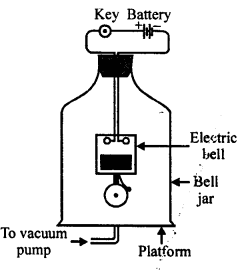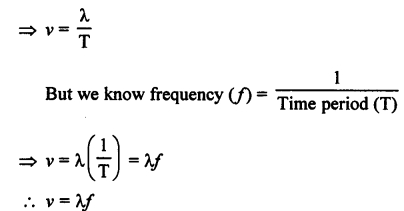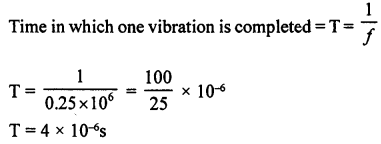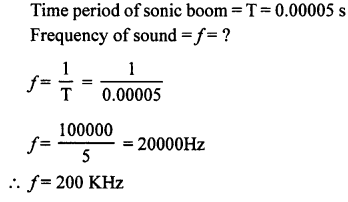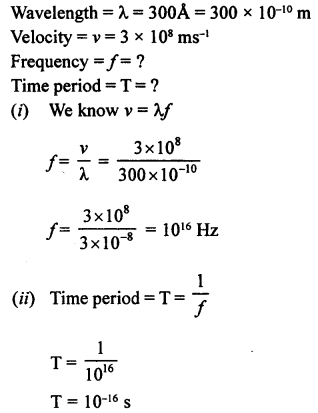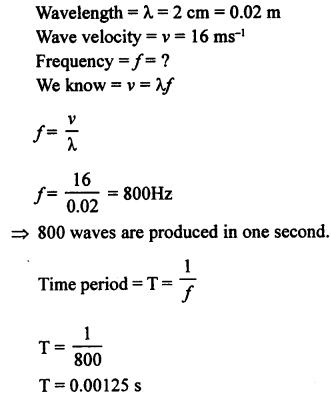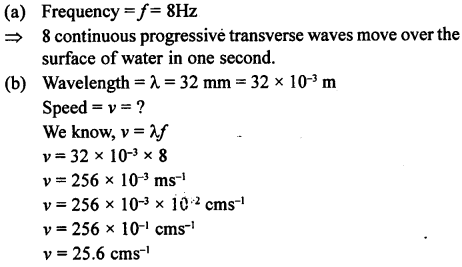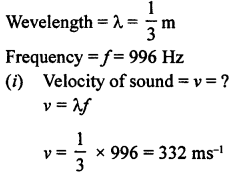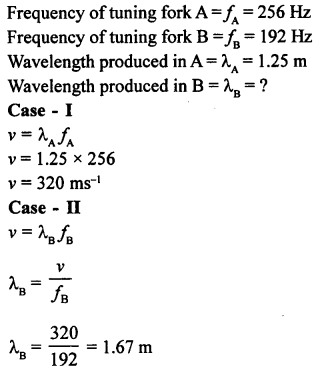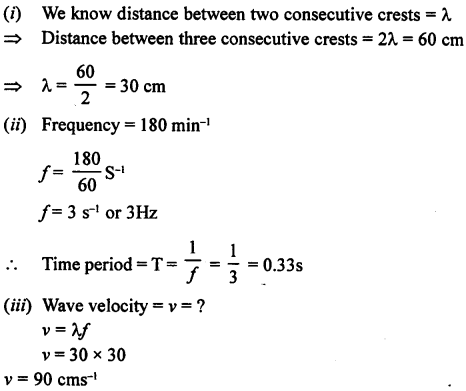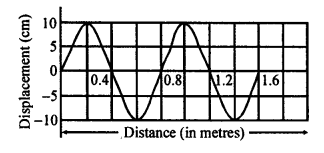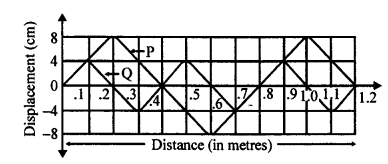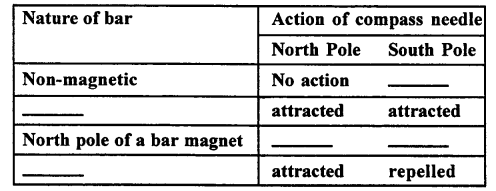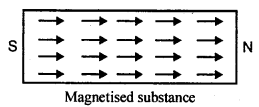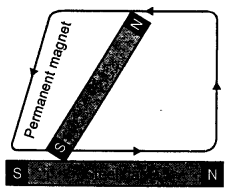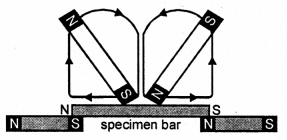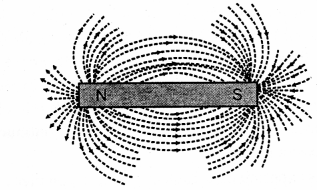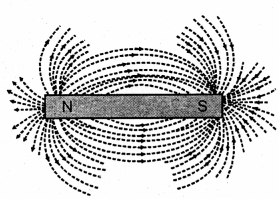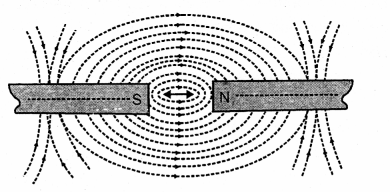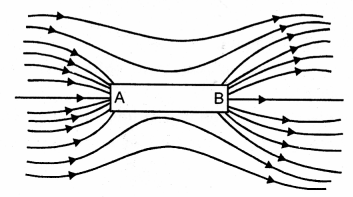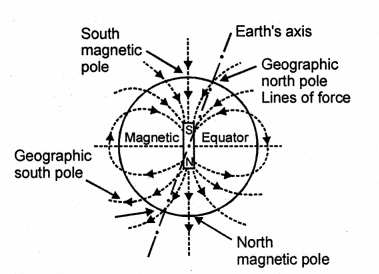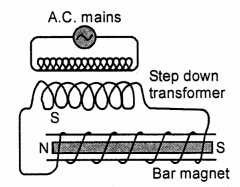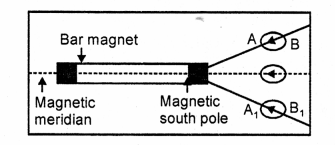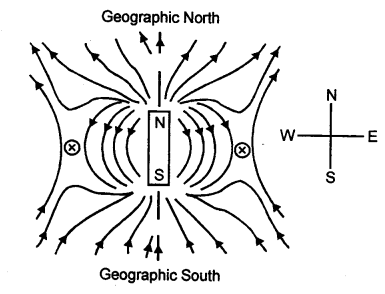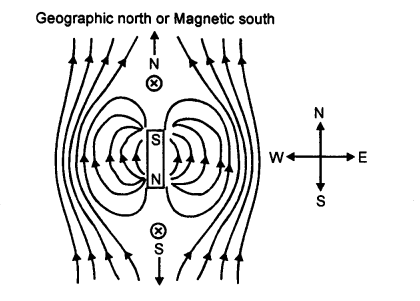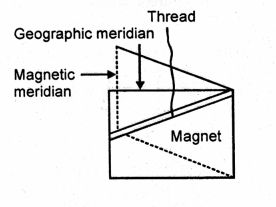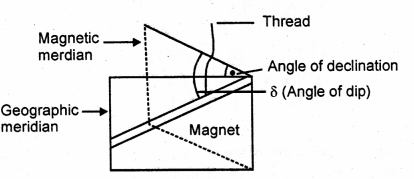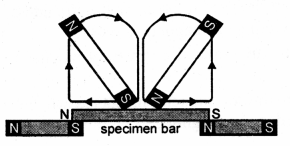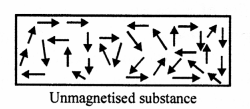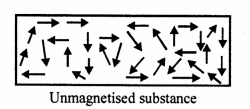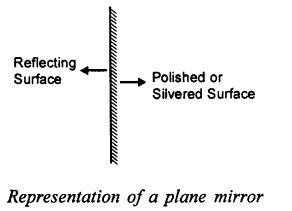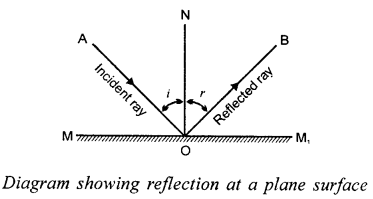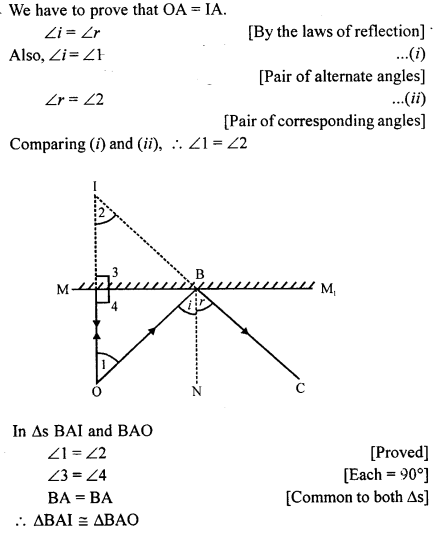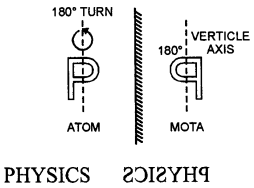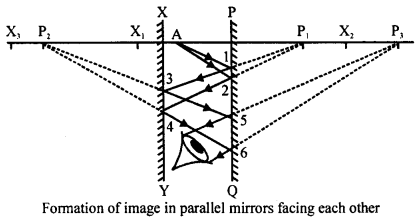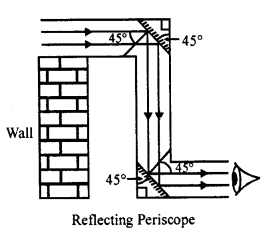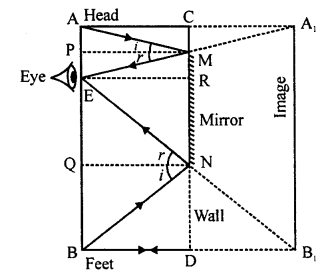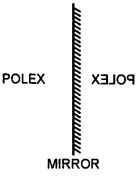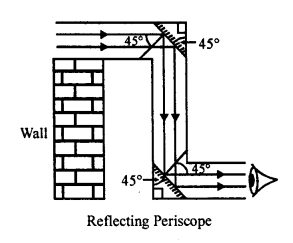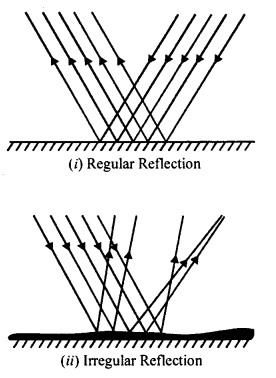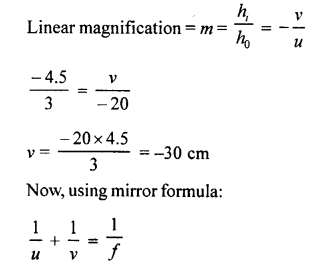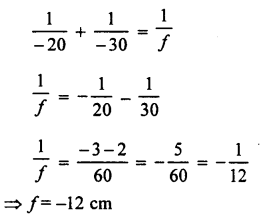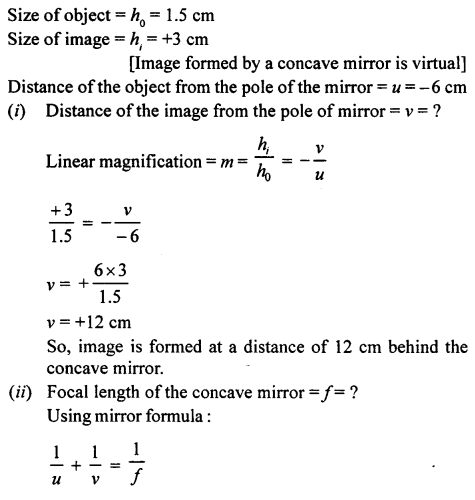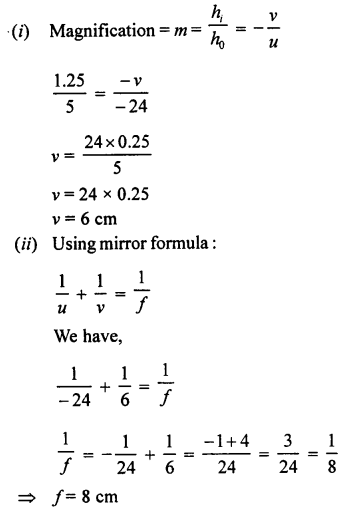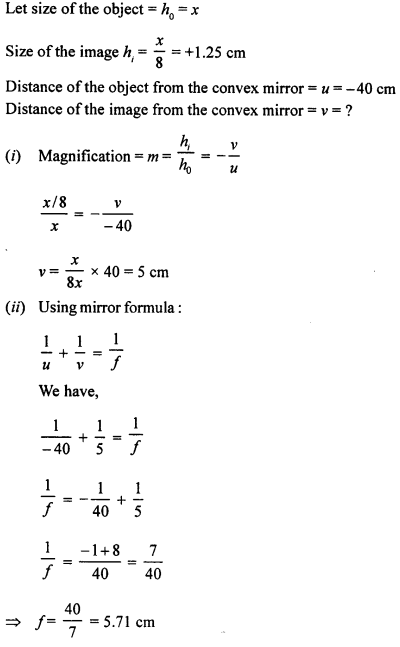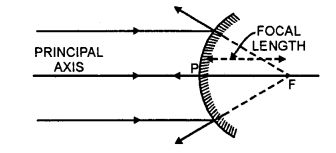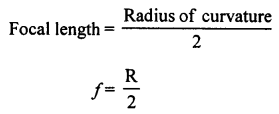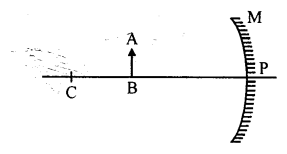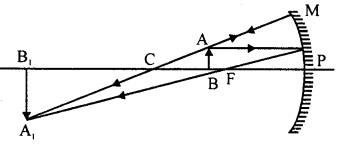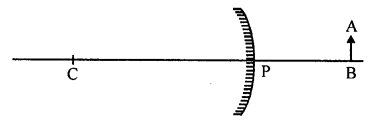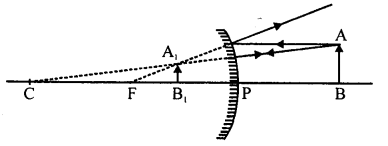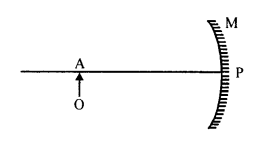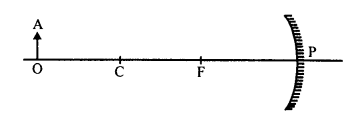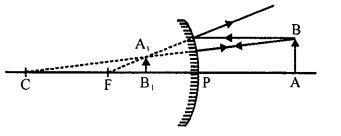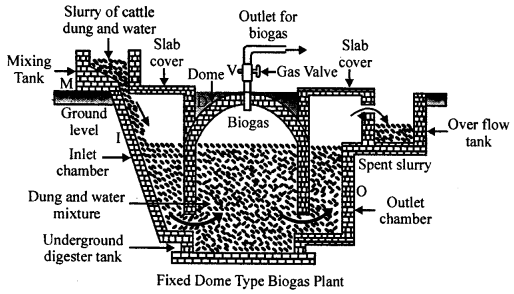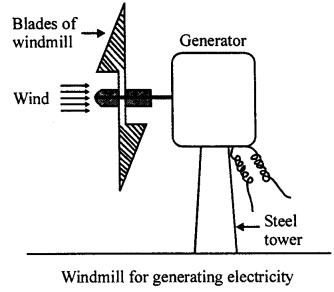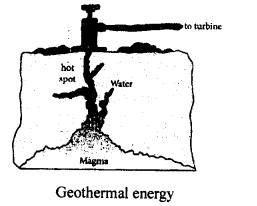A New Approach to ICSE Physics Part 1 Class 9 Solutions Electricity and Magnetism – 1
These Solutions are part of A New Approach to ICSE Physics Part 1 Class 9 Solutions. Here we have given A New Approach to ICSE Physics Part 1 Class 9 Solutions Electricity and Magnetism – 1
Unit I
Exercise 1
Question 1.
There is a positively charged sphere A and negatively charged sphere B, such that they are brought in electrical contact by a copper wire. Answer the following questions :
(a) Which sphere is at higher potential before electrical contact on the basis of convention?
(b) Which sphere is at lower potential before electrical contact on the basis of convention?
(c) In which direction conventional current flows?
(d) In which direction electronic current flows?
(e) What is potential of the spheres after electrical contact?
Answer:
Sphere A is positively charged and sphere B is negatively charged.
Both the sphere A and B are brought in electrical contact by a copper wire.
(a) On the basis of convention, positively charged sphere A is at higher potential before electrical contact.
(b) On the basis of convention, negatively charged sphere B is lower potential before electrical contact.
(c) Conventional current flows from sphere A to sphere B i. e. from a body at higher potential to the body at lower potential.
(d) Electronic current flower from sphere B to sphere A i.e. from a body at lower potential to the body at higher potential.
(e) After electrical contact, both the spheres will be at same potential.
Question 2.
(a) What do you understand by the term electric potential?
(b) Define electric potential in terms of energy spent.
(c) State the unit of electric potential and define it.
Answer:
(a) Electric potential : The amount of work done in moving a unit positive charge from infinity to a given point in an electric field is called electric potential.
(b) Electric potential : The amount of energy spent in moving a unit positive charge from infinity to a given point in an electric field is called electric potential.
(c) Volt is the SI unit of electric potential.
One volt : When one coulomb of charge is brought from infinity to a given point in an electric field, such that work done is one joule, then electric potential is said to be one volt.
OR
Electric potential is said to be one volt if one Joule of work is done in moving one coulomb of charge from infinity to a given point in an electric field.
Question 3.
(a) What do you understand by the term quantity of electric charge?
(b) State SI unit of electric charge and define it.
(c) How many electrons constitute one unit electric charge in SI system?
Answer:
(a) Quantity of electric charge : The number of charge (electrons) which drift from lower to higher potential is called quantity of charge.
(b) SI unit of electric charge is coulomb (C).
One coulomb : The quantity of electric charge which will deposit 0.00118 g of silver on the cathode, when passed through silver nitrate is called one coulomb.
(c) 6.25 × 1018 electrons constitute one unit (IC) electric charge in SI system.
Question 4.
(a) What do you understand by the term electric current?
(b) State and define the SI unit of electric current.
(c) State the relation between electric current; number of electrons moving in a circuit and time in seconds.
Answer:
(a) Electric current : The rate of flow of electric charge in an electric circuit is called electric current.
(b) Ampere (A) is the SI unit of electric current.
One ampere : When one coulomb charge flows through an electric circuit in one second, then the electric current flowing the circuit is said to be ampere.
(c) If Q is the charge (in coulombs) flowing through conductor in time t (in seconds) such that current I flows through the conductor then
Rate of flow of charge = Q/t
We know rate of flow of charge = I = Electric current.
⇒ I = Q/t
Question 5.
How electric current flows in (i) solids, (ii) liquids?
Answer:
(i) Flow of electric current in solids : In solids, the positive charges are associated with atomic nuclei. As the nuclei are firmly packed and closely held by inter-atomic forces, therefore, positive charges cannot drift.
On the other hand, negative charges (electrons) are not held firmly. Thus, when a potential difference, however small, is applied they start drifting from lower to higher potential.
The continuous drift of electrons, through the body of a solid conductor constitutes the current.
(ii) Flow of electric current in liquids : Within a liquid no electrons move. However, when a negatively charged and a positively charged electrodes are placed in a liquid, it sets up an electric field.
Under the influence of the electric field, the positively charged ions migrate towards the negatively charged electrode and vice versa.
At the cathode the positively charged ions gain electrons. At the anode the negatively charged ions lose same number of electrons.
Thus, in a way number of electrons given by the cathode is equal to the number of electrons accepted by the anode. The sum up, we can say that simultaneous movement and discharge of positive and negative ions in the opposite directions constitutes the current in the liquids.
Question 6.
(a) Define the term potential difference.
(b) How is potential difference related to work done and quantity of charge?
Answer:
(a) Potential difference : The amount of work done in moving a unit positive charge from one point to another point in an electric field is called potential difference.
(b) If Q = Charge moving from one point to another in an electric field.
W = Work done to move the charge Q from one point to another.
V = Potential difference between two points.
Then work done in moving Q units of charge = W
Work done in moving one unit of charge = W/Q
But work done in moving one unit of charge = Potential difference = V
⇒ V = W/Q
Practice Problems 1
Question 1.
A charge of 5000 C flows through an electric circuit in 2 hours and 30 minutes. Calculate the magnitude of current in circuit.
Answer:
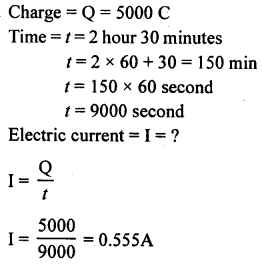
Question 2.
A charge of 8860 C flows through an electric circuit in 2 min and 40 s. Calculate the magnitude of current in circuit.
Answer:

Practice Problems 2
Question 1.
A battery can supply a charge of 25 × 104 C. If the current is drawn from battery at the rate of 2.5 A, calculate the time in which battery will discharge completely.
Answer:
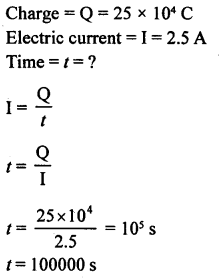
Question 2.
A dry cell can supply a charge of 800 C. If continuous current of 8.0 mA is drawn, calculate the time in which cell will discharge completely.
Answer:

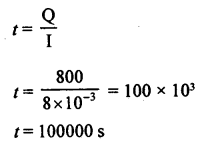
Practice Problems 3
Question 1.
Calculate the total number of electrons flowing through a circuit in 20 mins and 40 s, if a current of 40 μA flows through the circuit.
[1 e– = 1.6 × 10-19 C]
Answer:

Question 2.
4 × 1020 electrons flow through a circuit in 10 hours. Calculate magnitude of current. [1 e- = 1.6 × 10-19 C]
Answer:


Practice Problems 4
Question 1.
What is the electrical potential at a point in an electric field when 24 J of work is done in moving a charge of 96 C from infinity?
Answer:
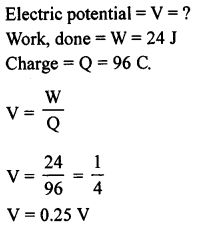
Question 2.
A charge of 75 C is brought from infinity to a given point in an electric field, when amount of work done is 3.75 J. Calculate the electrical potential at that point.
Answer:
![]()
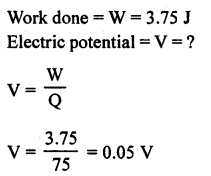
Practice Problems 5
Question 1.
A work of 25 J and 30 J is done when 5 C charge is moved first to point A and then to point B from infinity. Calculate the potential difference between points A and B.
Answer:
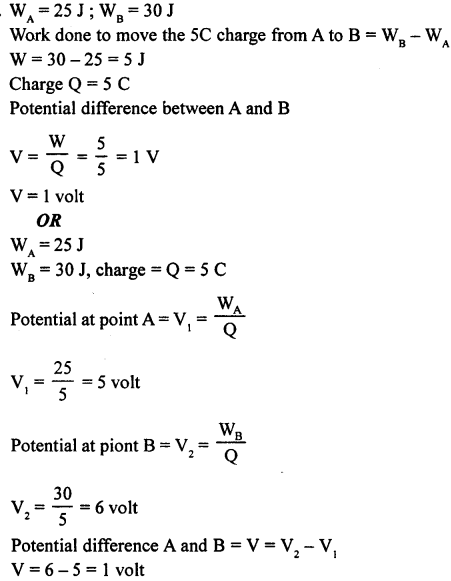
Question 2.
A charge of 25 C is moved from infinity to points A and B in an electric field when the work done to do so is 10 J and 10.5 J respectively. Calculate the potential difference between the points A and B.
Answer:
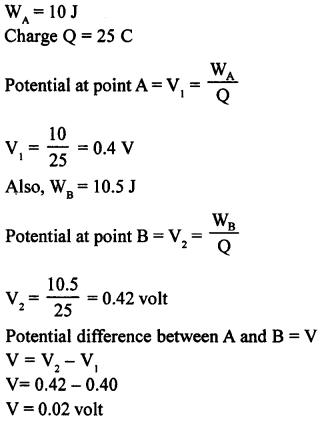
Unit II
Exercise 2
(A) Objective Questions
Multiple Choice Questions.
Select the correct option :
1. SI unit potential difference is :
(a) coulomb
(b) kelvin
(c) volt
(d) ampere
Ans. (c) volt
2. Current in a circuit flows :
(a) in a direction from high potential to low potential
(b) in a direction from low potential to high potential
(c) in a direction of flow of electron
(d) in any direction
Ans. (a) in a direction from high potential to low potential
3. In a metallic conductor, electric current is thought to be due to movement of :
(a) ions
(b) amperes
(c) electrons
(d) protons
Ans. (c) electrons
4. Assuming that the charges of an electron is 1.6 × 10-19 coulombs, the number of electrons passing through a section of wire per sec, when the wire carries a current of one ampere is :
(a) 0.625 × 1019
(b) 1.6 × 10-19
(c) 1.6 × 1019
(d) 0.627 × 10-17
Ans. (a) 0.625 × 1019
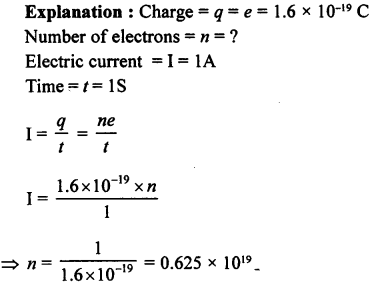
5. Which of the following is best conductor of electricity?
(a) copper
(b) gold
(c) platinum
(d) silver
Ans. (d) silver
(B) Subjective Questions
Question 1.
What do you understand by the term electric cell?
Answer:
Electric cell is an arrangement which maintains constant potential difference between conductors.
A cell basically consists of two conducting rods, which are called electrodes, immersed in a solution, which is called the electrolyte.
Question 2.
Draw a neat and labelled diagram of simple voltaic cell showing clearly the direction of flow of conventional current and direction of flow of electrons.
Answer:
Simple voltaic cell was invented by Alessandro Volta in year 1800. It was the first device which could creat a constant potential difference between two plates with the help of chemical energy.

Question 3.
Briefly describe the theory of simple voltaic cell.
Answer:
Theory of simple voltaic cell: Amongst the zinc and copper plates, zinc is more electro-positive (ionisation potential – 0.76 V) as compared to copper
(ionisation potential + 0.34 V) in electrochemical series. The dilute sulphuric acid is used as an electrolyte in the ionised state.
![]()
When zinc plate comes in contact with (H+) hydrogen ions, it being more electro-positive, ionises to form zinc ions and free electrons.
![]()
The free electrons so formed, take the passage of least resistance, and hence, move out in the external circuit through the copper wires. The zinc ions, however, enter in the dilute sulphuric acid. Since Zn2+ ions are positively charged, they repel H+ ions in the acid solution, with the result that H+ ions start crowding at the copper plate.
The copper plate in turn loses its free electrons to H+ ions, which . form nascent hydrogen.
![]()
The nascent hydrogen atoms so formed unite to form molecular hydrogen.
![]()
From the above explanation, it is clear that free electrons actually drift from zinc to copper in external circuit, and hence, current should flow from zinc to copper.
However, we still continue saying the electric charge flows from copper to zinc and this current is called conventional current, whereas the actual flow of electrons is from zinc to copper which constitutes electronic current.
The emf between the zinc copper plate in the external circuit is 0.34 V – (-0.75 V)= 1.10 V.
Question 4.
What do you understand by the following terms?
- electric circuit
- closed electric circuit
- open electric circuit.
Answer:
- Electric circuit : The path along which electric current flows is known as electric circuit.
- Closed electric circuit : W’hen the path of an electric circuit starting from one terminal of the cell, ends at the other terminal of cell, without any break, then such a circuit is called closed circuit.
- Open electric circuit : When the path of an electric circuit, starting from one terminal of the cell, is broken at some point, then such a circuit is called open electric circuit.
Question 5.
State two conditions necessary for a circuit, such that electric current flows through it.
Answer:
For the flow of electric current through a circuit, following are the necessary conditions :
- Electric circuit must be closed or complete.
- Every part of the circuit is a conductor.
Question 6.
Draw a neat diagram showing
- closed electric circuit
- open electric circuit.
Answer:
- Closed circuit
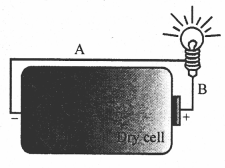
- Open circuit
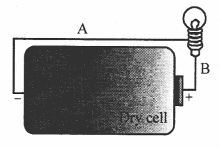
Question 7.
Name four electric conductors and four electric insulators.
Answer:
- Conductors : Silver, copper, aluminium and iron.
- Insulators : Plastic, nylon, dry wood and rubber.
Question 8.
(a) What do you understand by the term electric resistance?
(b) Why does the filament of an electric bulb in an electric circuit get white hot, but not the connecting wires?
Answer:
(a) Electric resistance : The obstruction offered to the passage of electric current by a material is called resistance of the material.
(b) Filament of an electric bulb is made up of tungsten having high resistance. Due to its high resistance, on passing electric current through it, a electrical energy changes into heat energy. So much heat is produced that filament of bulb becomes white hot and gives light.
Resistance of connecting wires is very low and hence the connecting wires do not get heated.
Question 9.
Is it correct to say that a resistance wire is an insulator or a bad conductor? Explain your answer.
Answer:
It is not correct to say that a resistance wire is an insulator or bad conductor. From resistance, it is implied that a gien material will conduct electricity, but will also offer obstruction to the passage of electric current.
Question 10.
(a) What do you understand by the term series circuit?
(b) State two characteristics of resistances in the series circuit.
(c) Draw a diagram showing two bulbs connected in series to a dry cell.
Answer:
(a) Series circuit : When a number of resistances are connected in an electrical circuit in such a way that positive of one resistance acts as the negative of the other resistance, then resistances are said to be in series.
OR
A number of resistors are said to be in series if these are joined end to end and same current flows through each one of them when a potential difference is applied across the combination.

(b) Characteristics of resistances in series :
- The sum total of resistances in series increases with increase in number of resistors.
- The potential difference remaining constant, the current in series circuit decreases with the increase in number of resistors in series.
- All the elements in series circuit work simultaneously. If the circuit is broken anywhere between the elements, none of the elements work.
(c) Two bulbs glowing dimly
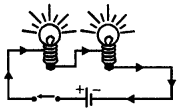
Question 11.
(a) What do you understand by the term parallel circuit?
(b) State two characteristics of resistance in the parallel circuit.
(c) Draw a diagram showing two bulbs connected in parallel to a dry cell.
Answer:
(a) Parallel circuit : When a number of resistances (bulbs) are connected in an electrical circuit in such a way that all of them are connected to common positive and common negative terminal of a cell, then the resistance (bulbs) are said to be connected in parallel.
OR
A number of resistors are said to be connected in parallel if one end of each resistor is connected to one point and other end of each resistor is connected to another point so that the potential difference across each resistor is same.
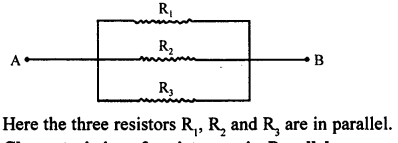
(b) Characteristics of resistances in Parallel :
- The sum total of resistances in parallel decreases with the increase in number of resistors.
- The current flowing in any resistor in parallel will be inversely proportional to resistance i.e., more the resistance, less the current.
- Each resistor in parallel functions independently with respect to the other resistors in parallel.
(c)
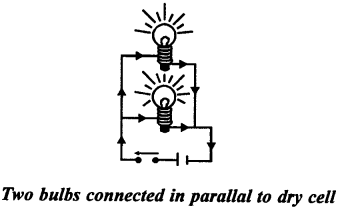
More Resources
- A New Approach to ICSE Physics Part 1 Class 9 Solutions
- ICSE Solutions for Class 9 Hindi
- ICSE Solutions for Class 9 Geography
- ICSE Solutions for Class 9 History and Civics
- ICSE Solutions for Class 9 English Literature and Language
- Selina ICSE Solutions for Class 9 Maths
- Selina ICSE Solutions for Class 9 Physics
- Selina ICSE Solutions for Class 9 Chemistry
- Selina ICSE Solutions for Class 9 Biology
- New Simplified Chemistry Class 9 ICSE Solutions
Hope given A New Approach to ICSE Physics Part 1 Class 9 Solutions Electricity and Magnetism – 1 are helpful to complete your science homework.
If you have any doubts, please comment below. APlusTopper try to provide online science tutoring for you.

